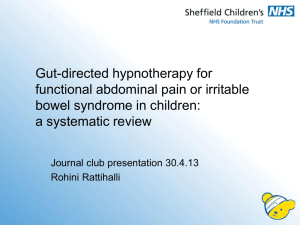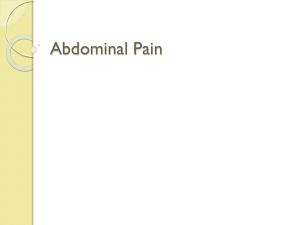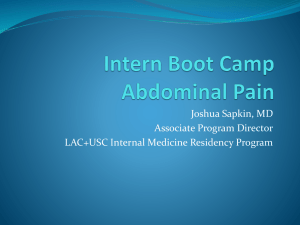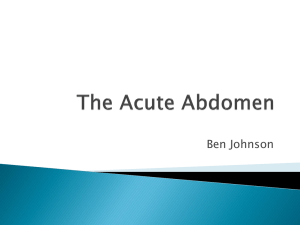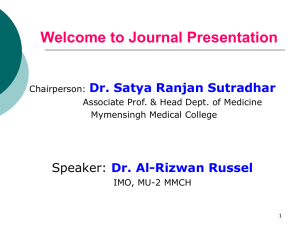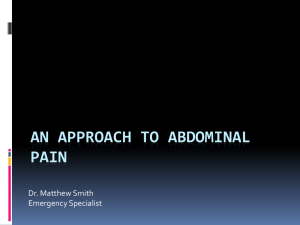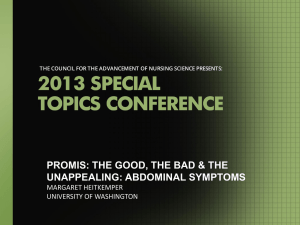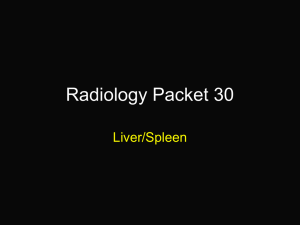Am J Gastroenterol - Benton Franklin County Medical Society
advertisement
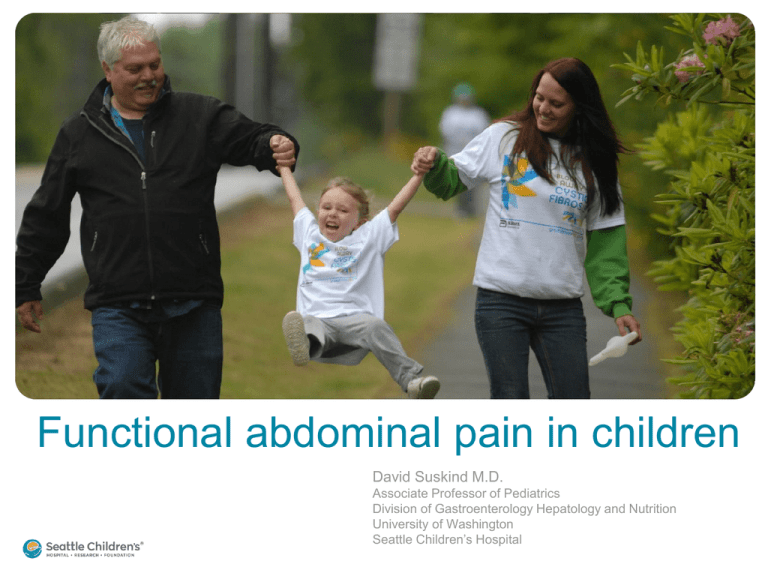
Functional abdominal pain in children David Suskind M.D. Associate Professor of Pediatrics Division of Gastroenterology Hepatology and Nutrition University of Washington Seattle Children’s Hospital Disclosure Statement • I do not have any financial interest, arrangement or affiliation with medical/pharmaceutical/equipment companies Objectives • Understand the definition and classification of pain predominant functional gastrointestinal disorders • Synthesize various factors involved in their pathophysiology • Apply the pathophysiology principles in understanding evidence based treatments Epidemiology - Functional GI Disorders • Vast majority of ALL childhood abdominal pain is functional • 2-4% of all general pediatric visits • >50% of consultations in pediatric GI • Frequently misdiagnosed • Significant morbidity • Quality of life substantially poorer than in those suffering from asthma or migraine What’s in a name? Chronic Recurrent Abdominal Pain CRAP Recurrent Abdominal Pain RAP CAP Chronic Abdominal Pain FAP Functional Abdominal Pain All roads lead to Rome • Rome III abdominal pain-related FGIDs • • • • Functional dyspepsia Irritable bowel syndrome Abdominal migraine Childhood functional abdominal pain Diagnostic Criteria for Functional Dyspepsia 1. Persistent or recurrent pain or discomfort centered in the upper abdomen (above the umbilicus) 2. Not relieved by defecation or associated with the onset of a change in stool frequency or stool form (i.e., not IBS) 3. No evidence of an inflammatory, anatomic, metabolic, or neoplastic process that explains the subject’s symptoms * Criteria fulfilled at least once per week for at least 2 months before diagnosis Diagnostic Criteria for Irritable Bowel Syndrome (IBS) 1. Abdominal discomfort or pain associated with 2 or more of the following at least 25% of the time: a) Improved with defecation b) Onset associated with a change in frequency of stool c) Onset associated with a change in form (appearance) of stool 2. No evidence of an inflammatory, anatomic, metabolic, or neoplastic process that explains the subject’s symptoms * Criteria fulfilled at least once per week for at least 2 months before diagnosis Diagnostic Criteria for Abdominal Migraine 1. Paroxysmal episodes of intense, acute periumbilical pain that lasts for 1 hour or more 2. Intervening periods of usual health lasting weeks to months 3. The pain interferes with normal activities 4. The pain is associated with 2 or more of the following: a. Anorexia b. Nausea c. Headache d. Photophobia d. Pallor 5. No evidence of an inflammatory, anatomic, metabolic, or neoplastic process that explains the subject’s symptoms * Criteria fulfilled at least once per week for at least 2 months before diagnosis Diagnostic Criteria for Childhood Functional Abdominal Pain 1. Episodic or continuous abdominal pain 2. Insufficient criteria for other FGIDs 3. No evidence of an inflammatory, anatomic, metabolic, or neoplastic process that explains the subject’s symptoms * Criteria fulfilled at least once per week for at least 2 months before diagnosis “A Prescription for Abdominal Pain: Due Diligence” By Perri Klass, M.D. 11/22/2010 ‘The stomachache people look with some envy at the headache people. “For some reason people respect headaches,” said Dr. Carlo Di Lorenzo, a leading pediatric gastroenterologist and professor of clinical pediatrics at Ohio State. “I’ve never seen a parent or a pediatrician tell a child complaining of a headache, ‘You don’t have a headache – it’s not real.’ Bellyache is just as real as headache.”’ “It’s all in your head” “It’s all in your head” Psychological Biological Social Pathophysiology Visceral Hypersensitivity • Distention and excessively strong contractions are primary causes of digestive tract pain • Detected by mechanoreceptors • Hypersensitivity found in substantial subset of patients with IBS/FGID • Balloon inflation during sigmoidoscopy and endoscopy • Modulated by 5-HT3 • “Wind-up” / central sensitization phenomenon Early Life Events and Visceral Hypersensitivity • Pain sensing neuronal circuits are formed during the neonatal period • Adverse events early in life may “prime” a child for chronic abdominal pain • Trauma/surgery? • Stress? • Cow’s milk allergy? Saps et al. J Pediatr Gastroenterol Nutr 2011;52:166-9 Motility • Strong contractions during power propulsion underlie sensation of cramping abdominal pain • Power propulsion occurs more frequently and with stronger force in those with IBS with diarrhea • Chey et al. Am J Gastroenterol 2001;96:1499-506. • Prolonged colonic transit time in those with IBS and constipation • Agrawal et al. Am J Gastroenterol 2009;104:998-2004. Altered Gastrointestinal Flora • Qualitative and quantitative changes in gut flora have been described in IBS patients • Lower level of Lactobacillus spp. in IBS-diarrhea • Higher rates of small bowel bacterial overgrowth • Patients who received antibiotics in the previous months are 3 times more likely to develop functional symptoms Altered Gastrointestinal Flora • Post-infectious IBS • 36% of children with bacterial gastroenteritis met criteria for FGID 6 months later (vs 11% of controls) • Changes in flora may alter visceral perception and motility Saps et al. J Peds 2008;152:812-816 Psychological Factors Psychological Factors + + Pain Mastery - Engaged Copers Dependent Copers Self-reliant copers Avoidant copers Relationships - Walker et all. Pain 2006;122:43-52. Parenting Techniques • Aim: to assess the impact of parent attention versus distraction on symptom complaints Walker et al. Pain 2006;122:43-52. Parenting Techniques • Aim: to assess the impact of parent attention versus distraction on symptom complaints • Included children with and without FAP • Water load provocation to induce pain • Parents randomly assigned/trained to: attention, distraction, or no instruction • Self-reported GI symptoms recorded before and after parent interaction • Parents’ and children’s perceptions of their interaction were assessed Walker et al. Pain 2006;122:43-52. Study Results • Symptom complaints by both FAP and well children: • Nearly doubled in the ‘Attention’ group • Reduced by half in the ‘Distraction’ group • Children in the ‘Distraction’ group rated parents as making them feel much better than ‘Attention’ group • Parents rated distraction as having greater potential negative impact on their children than attention Walker et al. Pain 2006;122:43-52 Pathophysiology - Review • Biopsychosocial model • Visceral hypersensitivity • Central sensitization / “Wind-up” phenomenon • Possible effect from early life events • • • • Motility disturbance Altered gastrointestinal flora Psychologic factors, including coping strategies Parenting techniques Natural History Natural History • Children with RAP seen by a subspecialist more likely to have anxiety, depression, and migraine headaches as adults • Campo et al. Pediatrics 2001:108:e1 • 35% of children with FAP (N=188) had persistent FGID at follow-up 4-15 years later • Prevalence of non-GI somatic complaints associated with persistent functional disease • Dengler-Crish et al. .J Pediatr Gastroenterol Nutr 2011;52:162-5. Making the diagnosis • History • Children with FAP are more likely to have headache, joint pain, anorexia, nausea, excessive gas, and altered bowel habits • Yet none of these symptoms can distinguish functional from “organic” abdominal pain Alarm Symptoms • • • • • • • Involuntary weight loss or growth failure Dysphagia Frequent vomiting Chronic, severe diarrhea Nocturnal symptoms, especially BM’s Persistent RUQ or RLQ pain Rectal bleeding without constipation Appropriate work-up • Predictive value of blood tests not well studied • No evidence that ultrasound of abdomen/pelvis has significant yield • EGD NOT indicated without alarm symptoms • Subcommittee on Chronic Abdominal Pain. Pediatrics 2005;40:24961. • Negative EGD does not reassure /improve outcome • Bonilla et al. Clin Pediatr 2011;(epub ahead of print). Treatment • Pharmacotherapy • Probiotics • Psychological • Cognitive Behavioral Therapy • Hypnotherapy • Biofeedback • Complementary and Alternative • Acupuncture Pharmacotherapy • “Primum non nocere” Peppermint Oil • RDBPCT of 42 children with IBS • Enteric coated peppermint oil capsules vs placebo • After 2 weeks, 75% of peppermint oil group had decreased severity of pain vs 19% with placebo • Limitations • Short study • Entry criteria not well described • Kline et al. J Pediatr 2001;138:125-8. Antibiotics • Rifaximin • 2 DBPCTs randomized 1260 patients to rifaximin (550 mg TID) or placebo x 2 weeks • Primary endpoint = proportion with self-reported relief for at least 2 of the 4 weeks immediately post treatment • 40% relief with rifaximin vs 31% with placebo (p<0.001) • Effect “persisted” at 12-week follow-up • Pimentel et al. NEJM 2011;364:22-32. Rifaximin Probiotics • RCT of Lactobacillus GG (LGG) vs placebo in children with FAP or IBS • • • • N = 144 (9 primary care sites and 1 referral center) LGG (3x109 BID) vs placebo for 8 weeks 8-week follow-up phase LGG but not placebo significantly reduces the frequency (p<0.01) and severity (p<0.01) of abdominal pain by end of treatment • Effects persisted at 8-week follow-up • Francavilla et al. Pediatrics 2010;126:e1445-52. Lactobacillus GG Amitriptyline • Children with FAP, IBS, or functional dyspepsia randomized to 4 weeks placebo or amitriptyline • 10 mg/d, weight <35 kg; 20 mg/day, weight >35 kg • Pain, psychological traits, and daily activities assessed before and after intervention • Primary outcome = self assessment of pain relief and sense of improvement • Saps et al. Gastroenterology 2009;137:1261-9. Cognitive Behavioral Therapy • 200 children/parents with FAP randomized to : • 3 session intervention of CBT: relaxation training; modifying response to illness/wellness; altering dysfunctional thoughts about symptoms • 3 session education intervention controlled for time and intervention • Children and parents assessed pre-treatment and serially up to 6 months post-treatment • Outcome measures: child and parents reports of pain levels, function, and adjustment • Levy et al. Am J Gastroenterol 2010;105:946-956. CBT - Results • CBT group with greater baseline to follow-up decrease in pain and GI symptoms (p<0.01) • CBT parents with greater decreases in solicitous responses to child’s symptoms (p<0.0001) Levy et al. Am J Gastroenterol 2010;105:946-956. Hypnotherapy Vlieker et al. Gastroenterology 2007;133:1430-1436. Hypnotherapy - Study design • Gut directed hypnotherapy (HT) • Single experienced provider • 6 sessions of 50 minutes over a 3-month period • Specific protocol, adapted to child’s developmental age • Control of gut functions • General relaxation • Ego strengthening suggestions • Standard medical therapy (SMT) • Education • Dietary advice and added fiber • “Pain medications” or PPIs, if necessary • 6 therapy sessions to explore stressful factors and/or triggers • Provided with CD and encouraged to practice self-hypnosis Vlieger et al. Gastroenterology 2007;133:1430-1436. Study Design - Outcomes • Pain intensity and frequency measured serially up to 12 months after therapy • Remission: >80% decrease in pain intensity and frequency scores Vlieger et al. Gastroenterology 2007;133:1430-1436. Figure 2. Changes in pain intensity scores during and after treatment Vlieger et al. Gastroenterology 2007;133:1430-1436. Figure 3. Changes in pain frequency scores during and after treatment Vlieger et al. Gastroenterology 2007;133:1430-1436. Table 2. Percentage of Patients in Clinical Remission After therapy No effect Improved Clinical remission At 6 mo follow-up At 1 yr follow-up SMT group (n = 25) (n = 27) HT group SMT group HT group SMT group HT group (n = 24) (n = 27) (n = 24) (n = 27) 56% 32% 12% 66% 17% 17% 15% 26% 59% 7% 22% 71% 46% 29% 25% 4% 11% 85% P < .001 between the treatment groups at all end points. Vlieker et al. Gastroenterology 2007;133:1430-1436. Biofeedback • Excellent evidence for chronic headaches • Data lacking for abdominal pain, but seems to work! Complementary Medicine • Acupuncture Complementary Medicine • Acupuncture Magge and Lembo. Gastroenterol Clin N Am 2011;40:245-253. Treatment - Conclusions • Peppermint oil may have some role • Emerging data for efficacy of probiotics • Psychological based treatment, particularly cognitive behavioral therapy and gut directed hypnotherapy are the most effective, evidencebased treatments Summary • Almost all chronic abdominal pain in children is functional • Concept should be introduced to families early • It’s not just “in your head!” • Cognitive behavioral therapy and hypnotherapy are the most evidence-based therapies • Key to effective treatment is the patientphysician relationship
